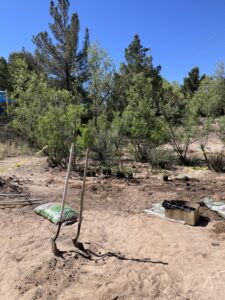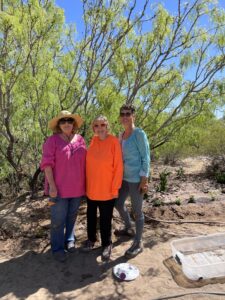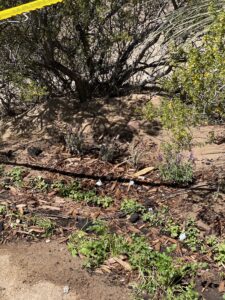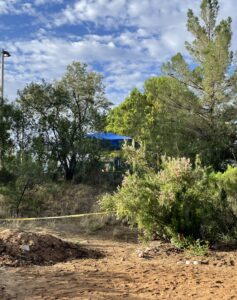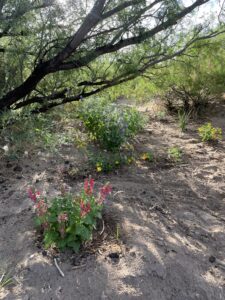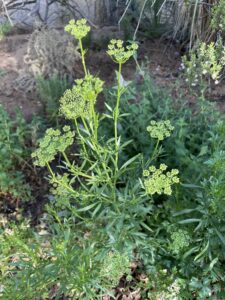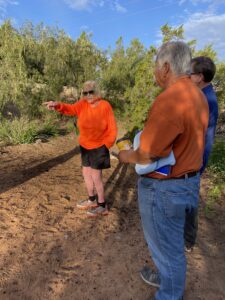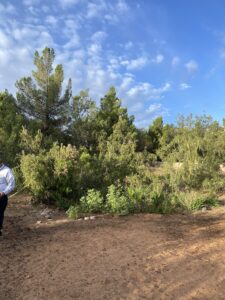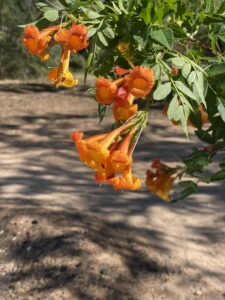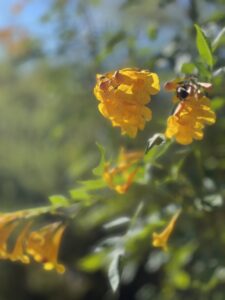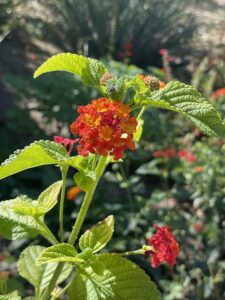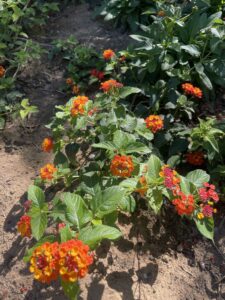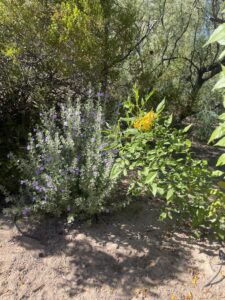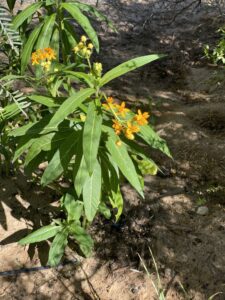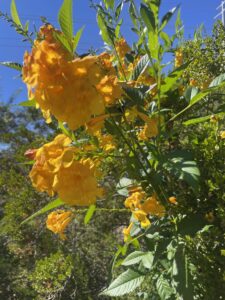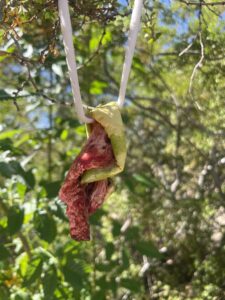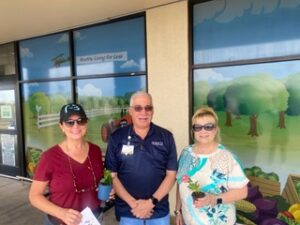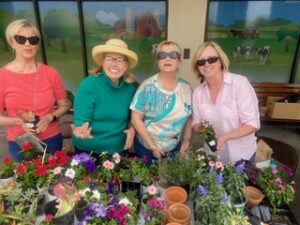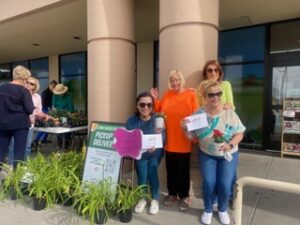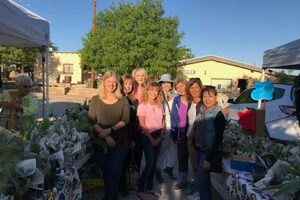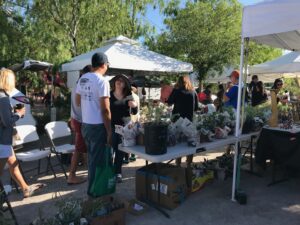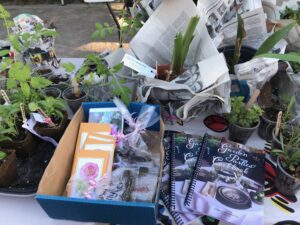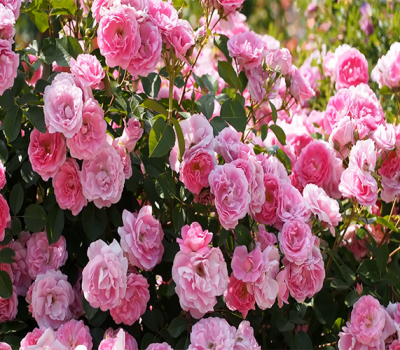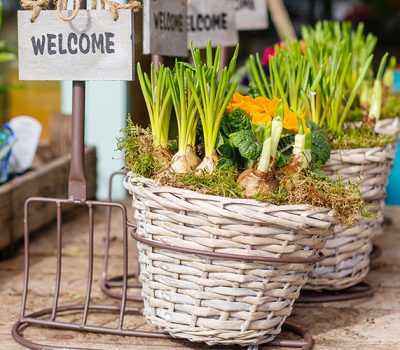Get Inspired
Gardening Projects
EDV Butterfly Garden
Community Project
The EDV Butterfly Garden is in Montoya Heights Park, 350 Coates off Doniphan Drive and is a first for El Paso, Texas. This Garden was made possible by Braden Aboud Foundation, Montoya Heights Association, El Paso Parks and Recreation, Sunrise Rotary and El Dedon Verde Garden Club.
Watching butterflies flitting from flower to flower in a garden is always a joy. The garden plants are named as shown is in 3 different “Niches” and they grow various nectar producing plants to feed adult butterflies and host plants to feed their caterpillars. The Garden was designed and built specifically to showcase the life cycle and free flight of butterflies and moths.
The EDV Butterfly Garden Project is designed to make use of an unutilized area of a drainage arroyo to cultivate desert indigenous plants that require little water or maintenance. These plants will be attractive to the development and cultivation of butterflies. This feature has added a unique quality to the park that doesn’t yet exist in any other park in town. The elementary school next door has shown tremendous enthusiasm for the potential to have a live lab to complement science and biology classes. A real-life hands-on demonstration for classes they study has certainly stimulated interest from the students and park patrons alike.
The outdoor is a calming riot of tropical color, aromas and personalities. Stars of the show are butterflies themselves fluttering amongst the flora! Enjoy up close the stunning beauty and color of butterflies and birds. Experience this living, breathing visual feast and enjoy a voyage of discovery into the life of inhabitants.
Share-A-Plant Day
Community Project
May of 2023 El Dedon Verde members gathered at Sprouts with Chair - Pat Rice for a wonderful day of sharing our love of gardening with our community An annual event where members donate plants they’ve started from seeds, cuttings or other forms of propagating and greet the customers of our local Sprouts.
Pictured here are EDV members Ana Gonzalez, Sprouts Manager and Project Chair-Pat Rice;June Peterson, Bobette Lange, Claire Jacobs, Judy Wendt, Debbie Hester, Martha Troeger, and Karen McAnulty all participated in making this years Share - A - Plant project a huge success!
gardening S.O.S.
Summer…the hardest season on the garden & the gardener…Re-mulch beds to conserve moisture.
- Water and feed regularly. It is best to water plants & lawns in the early morning or late evening.
- Water plants with a thorough soaking rather than frequent light sprinklings.
- For repeat bloom, shear back annuals & perennials that have finished their bloom.
- Keep annuals dead-headed & continue pinching mums.
- Prune climbing roses after first bloom & summer prune all roses to remove 1/3 of each cane that produced spring bloom.
- Plant caladiums when night temperature is above 65 degrees.
- Late July & August: plant or divide bearded iris & day lilies.
- Don’t mow bermuda grass too short.
- Tan speckles on lower leaves indicates spider mites. Hose plants with a strong jet of water for several days.
- First frost: November 13 (earliest on record October 6)
- Fall is for lawns. Cool air & warm soil is ideal to seed bald patches & feed the entire lawn.
- Plant shrubs, trees, & other perennials.
- Plant spring flower bulbs (refrigerate tulip & hyacinth bulbs for 6 weeks after purchase…..to make up for our shorter winter).
- Late September: divide day lilies & spuria iris.
- October, November, & early December: plant daffodils, Dutch iris, jonquils, oxalis, & ranunculus.
- Set out snapdragon, stock, daisy & pansy plants.
- Plant sweet pea, poppy, & larkspur seeds.
- Protect all potted plants or bring indoors before night temperature falls below 45 degrees.
- Improve your planting beds’ soil with compost & mulch over with organic material such as shredded leaves, pecan shells, or composted bark bits.
- Fall is also for starting seeds for spring veggies like peas, spinach, lettuce, Swiss chard, broccoli, etc.
- Irrigate deeply all plants every 2-3 weeks to prevent winter damage.
- January: prune trees & non spring-flowering plants. Plant new roses & new trees/shrubs. Save fireplace ashes as fertilizer for your iris & other alkaline soil plants.
- February: prune roses (except climbing) & spray fruit trees, roses, and all deciduous plants.
- Plant summer blooming bulbs (i.e., gladiolas, amaryllis, lycoris, nerine).
- Separate & transplant most perennials.
- March: plant/divide summer bulbs & tuberous roots like gladiolas, cannas, & day lilies. Also, perennials like phlox, gallardias, gazanias, carnations, & salvia. Begin pinching mums.
LAST FROST: March 21 (latest on record May 2)
- Prune Spring-blooming shrubs after they bloom.
- Check for and combat pests like red spider mites and aphids.
- Increase watering schedule & plant tender annuals after last frost.
- Begin routine feeding for all plants.
- Plant a summer vegetable garden.
- Plant dahlias in May.
- Brace yourself for the hot summer!

Seasonal Suggestions
You can get an early start on vegetable and flower gardening by planting seeds indoors. March is a great time to add color and interest by planting summer-flowering shrubs and vines. Flowering vines are a great way to dress up an entryway or to add color.
Try growing these pink-blooming vines: Queen's Wreath (Antigonon leptopus), shown here; pink bower vine (Pandorea jasminoides) or pink trumpet vine (Podranea ricasoliana). Red bird-of-paradise (Caesalpinia pulcherrima), Baja fairy duster (Calliandra californica), Texas sage (Leucophyllum frutescens), chaparral sage (Salvia clevelandii) and Arizona yellow bells (Tecoma stans stans) are large summer-flowering shrubs that add great color to the landscape.
Large shrubs, 5 feet and higher, should be planted toward the back of the landscape. Shrubs are a great way to hide a wall, fence and pool equipment from view. Plant lower-growing shrubs and perennials in front of taller shrubs.
Prune frost-damaged growth. Make sure to wait to prune until the danger of frost has passed. Not sure when your last frost date is? Check out your city's average frost dates.
For most fruit trees (apples, apricots and plums), you will get the best fruit production if you buy at least two different varieties of each type of tree. This is because many fruit trees cannot pollinate themselves; they rely on pollen from the same type of tree but a different variety.
Happy Gardening!

Play Video

